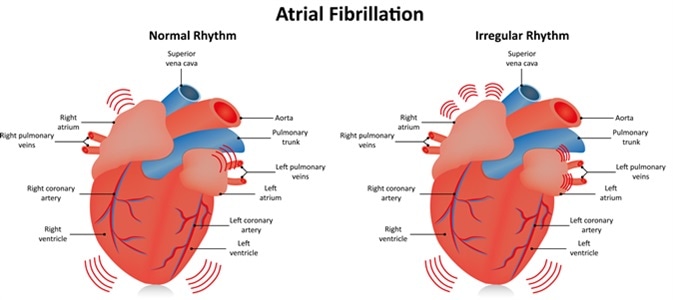Atrial fibrillation (AF) is a term denoting irregular heartbeat or arrhythmia that may lead to blood clots, heart failure, stroke, and other cardiac complications. With millions experiencing AF, the condition is accounts for about 2 percent of mortality rates from cardiac diseases.
Researchers have sought to study the mechanisms and factors involved in the development of the condition in order to provide relevant and effective measures of treatment.
Atrial remodeling was found to be an effective method of lessening such phenomenon. Studies have proven that remodeling or restructuring the heartbeats through various mechanisms limit the progression of the condition. As such, many physicians and medical practitioners resort to atrial remodeling when faced with a diagnosis of atrial fibrillation.

Atrial Fibrillation - Image Credit: Joshya / Shutterstock
Occurrence and Development of Atrial Fibrillation
Atrial fibrillation is believed to be a progressive cardiac disorder that ultimately induces electrical, microanatomical, neurohormonal, contractile, and ultrastructural changes within the cardiac system.
Starting out as a paroxysmal dysfunction, atrial fibrillation (through various genetic, physiological, and environmental influences) progresses into a persistent and permanent dysfunction. Studies in cardiology have established a link between risks for cardiovascular disorders and atrial fibrillation, with the latter found to develop more in patients with higher CVD risks or predispositions.
Being the most common form of arrhythmia, atrial fibrillation may occur at any age, but is extremely common among the elderly, probably because of its progressive nature. Studies have proven that AF is initiated when an atrial ectopic beat encounters anatomical or functional obstacles that in turn trigger wavefront excitation.
This specific excitation is characterized by triggered depolarization activities or by increased automaticity. Meanwhile, the persistence and progression of AF is explained as either the presence of re-entry circuits or the activities of cardiac electric rotors.
The Use of Atrial Remodeling
The past ten years saw the development of atrial remodeling as a tool in relieving the progression of atrial fibrillation. Any abnormality in atrial function constitutes a need for atrial remodeling; as such, many types of modeling techniques are currently available to address arrhythmic problems.
Electrical Remodeling
The utilization of electrical remodeling is done when several ion channels, associated with a shortening of the action potential (AP), are altered. Electrical remodeling particularly targets atrial electrophysiological parameters resulting from prolonged changes in the atrial rate.
By targeting atrial refractoriness and slowing down the conduction velocity of the atrial substrate, electrical remodeling is able to reduce the progression of AF. While the reversal of electrical remodeling usually takes place one week after the restoration of atrial fibrillation to sinus rhythm, the method may still be a long-term and repetitive endeavor.
Contractile Remodeling
A consequence of altered calcium handling, contractile remodeling is characterized by the loss of atrial contractility and atrial dilation. While this method shows promise, studies have argued that atrial dilation may facilitate atrial thrombosis during treatment period, which is why this remodeling technique is not recommended. Newer studies have challenged such theory, but more experiments and data should be conducted to test its accuracy and reliability.
Structural Remodeling
Primarily addressing the main activators of atrial fibrillation, structural remodeling targets the chronic atrial stretch and geometric deformations present within the cardiac structure. More specifically, this method targets both the cellular and non-cellular components of atrial tissues that facilitate further changes in atrial function. As this technique utilizes the same components that facilitate the progression of AF in the first place, structural remodeling is considered a less reversible technique that may lead to heart failure and other cardiac pathologies.
While various atrial remodeling techniques are currently available, the need for more appropriate AF solutions is still a relevant focus of contemporary medical research. Medical engineers, practitioners, and researchers are currently trying to develop technological cardiac innovations to be used for a more accurate and efficient AF treatment process.
Further Reading
Last Updated: Mar 13, 2023